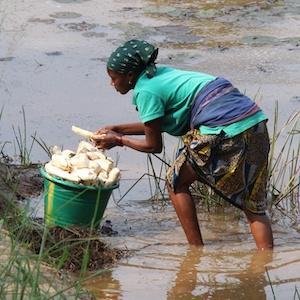In poor parts of the world, people may rely on a single staple crop to meet a substantial proportion of their energy requirements. For example, those who live in southeast Asia rely heavily on rice. Many denizens of Africa rely on cassava, a tuber somewhat reminiscent of a potato.
In the United States, cassava is mainly associated with tapioca, which is used in pudding or bubble tea. However, in Africa, cassava is essential for survival: About one-third of sub-Saharan Africans rely on it for more than half of their caloric intake.
The trouble with cassava, however, is that it is nutrient-poor. Partially as a result, iron and zinc deficiencies are common in Africa. Iron deficiency results in anemia, zinc deficiency in susceptibility to death by diarrhea, and each is also associated with impaired cognitive development. Breeding better varieties of cassava that absorb and store more of these nutrients is made difficult by a lack of genetic diversity. So, scientists have turned to biotechnology.
GMO Cassava Can Help Treat Iron and Zinc Deficiency
An international team of researchers, including scientists affiliated with the USDA, have genetically modified cassava to contain much higher levels of iron and zinc than the non-transgenic variety. They used two genes from thale cress (Arabidopsis thaliana), a pathetic looking plant that happens to be one of the most studied organisms in all of biology. The first gene was a derivative of IRT1, which encodes an iron transport protein. The second, FER1, encodes ferritin, an iron storage protein.
Modifying the plant with these two genes increased not only iron levels but zinc levels, as well. (See figure below. The left panel depicts iron levels; the right panel depicts zinc levels. The controls are on the left side of each panel; the others are experimental plants.)

The authors further assessed the effects of processing on nutrient retention. Cassava is not eaten raw. Instead, it is often turned into garri or fufu, and some iron and zinc are lost in this process. Using this data, combined with food consumption patterns, the authors estimate that their genetically modified cassava could provide up to 50% of the dietary requirement for iron and up to 70% for zinc in children aged 1 to 6 years, as well as non-lactating, non-pregnant women.
One wonders how the anti-GMO movement could oppose something like this. But given their hostility to Golden Rice, which has been genetically modified to contain a vitamin A precursor to prevent blindness, they usually find a way. For the sake of African children, let's hope they aren't successful.
Source: Narayanan Narayanan, et al. "Biofortification of field-grown cassava by engineering expression of an iron transporter and ferritin." Nature Biotechnology 37: 144-151. Published: 28-Jan-2019. DOI: 10.1038/s41587-018-0002-1




